HISTORY
SANTIAGO APOSTOL
Apostle of Jesus "James, the Son of Zebedee or the Elder", was John's elder brother, both of Bethsaida's inhabitants in nearby Capernaum, working in the family fishing business on the shores of Lake Gennesaret; Belonged, then, to a family of modest proprietors with his father Zebedee. They were associated with another pair of brothers, Pedro and Andrés in the fishing industry of the lake for whose work they had occasional employees. From this circle of fishermen Jesus took his first four disciples: Peter and his brother Andrew, James and his brother John.
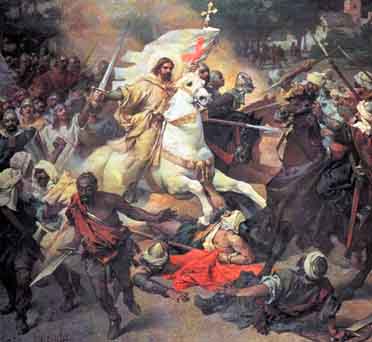
Santiago, he enjoyed a special trust and a relationship with Jesus as a disciple basic, by detaching with Juan Pierre and the rest of the disciples, obtaining the position of privileged witness in the most important moments. The same Jesus has called Santiago and Juan with the nickname "I kill children" (Mk III, 17). Santiago appears as a passionate person, full of courage and determination, able to put everything in a game, as a person who clears its thrust and not throw in the calculations and measure impact.
Santiago is part of the initial group of the early Church of Jerusalem. Santiago present in estuvo muy important momentos de la vida de Jesús y uno de sus ha considerado predilectos disciples. Asistió, junto con Juan and Pedro, the Resurrección the hija de Jairo. Fue testigo in the Transfiguración there estuvo también el El Huerto of Getsemaní.
Healthy Lucas (Luke ix, 33) tells one of his moments: near to his brother Juan de Jesús he asked who was down fire from heaven to overcome Samaritanos inhospitable who refused to give shelter to the master.
Tradition assigns it a great work of evangelization in the province Hispanic who contacted him in the distribution of the Apostles carried out to spread the Gospel of Christ. He probably came to Spain 41 years and stayed in it until a Finn year 42. He walked the roads Italic, Mérida, Coimbra, a panty, the Numancia Would go and Zaragoza, Lugo, Astorga, Palencia, Shape, where the Virgin Mary appeared there in the terminal. After the Ebro, he could take Route Auguste de Tortosa Valencia, Chinchilla and Cazlona to return from a port or murciano Andalusian Palestine ..
Herod Agrippa, king of Judea (Act XII, 2), a small - son of Herodes Great, beheaded with the sword to the year 44, becoming first apostle to shed his blood for Jesus Christ.
His body was moved by the Apostles to the Hispanic Peninsula, carried in the same boat Flavia Would go. They landed and walked about 4 miles north towards the old Roman road to Brigatium It Would go arriving at Liberodonum by burying the corpse. They raised a mausoleum, "Chest Marmorica" according diplomas Alfondo III Ordoño II, III and Sancho Ordoño Gras. According to tradition, close to the tomb of Santiago rested the body of his disciples Atanasio and Teodoro.
All this has seen the light in the time of Alfonso Chaste and Teodomiro, Bishop of Flavia Would go. In an event memory so happy, instead it was named "Campus stellae" or "Compostela".
King Alfonso II ordered to build a church on the grave and simple visitors begin to arrive at the tomb of the Apostle. During the time of the Reconquest, Santiago converts character who is invoked for divine protection in the fight against the infidel. The Santiago Matamoros arises a. And bloody struggles against the Moors, on several occasions victory is attributed to divine intervention and help one through the invocation of Santiago.
In year 844, another supernatural phenomenon would ultimately embrace the shape of Santiago as the incarnation of the Reconquest. May 23 in Clavijo, near Logroño, King Ramiro I of Asturias he is the head of Muslim troops Abderramán II in a light-handed. In a full din of battle the apostle Santiago is a sword in one hand the backs of his famous white horse by spreading cuts between the infidels. Christians win against a prognosis and myth jacobeo certainly crosses the Pyrenees. The common Santiago Matamoros is born.
In the tenth century the pilgrimage to Compostela is a fact consolidated into Christianity. This is the time of the coastal path, safer than those of the interior, exposing the Arab raids. It is from the year 1000 when pilgrimages are popularized in Santiago, as the pilgrims advance did with Rome or Jerusalem with palmeros. Monarchs have understood that maintaining the path was free and clear a road to ensure vital economic, commercial and military to control its territory.
Both are the kings who support more road jacobea: the Navarrese Sancho III the Greater and Castilian Alfonso VI. The path has a series of infrastructure (roads and bridges one) and places assistance for the pilgrim. Fundamental to this field was the religious orders in hospitals, among which this one is out of Cluny.
The first outbreak in Santiago pilgrimage is produced in the eleventh and twelfth centuries, coinciding with the splendor of Romanesque art. In 1122 the Papa Calixto II declared that the Holy Year Jacobeo in that it coincides July 25 on a Sunday. Multitudes of people began to arrive from all parts of Europe by giving a cosmopolitan touch to the towns through which the road passes. The French Way is used and Roncesvalles thousands and thousands of pilgrims are recorded in these years later with the conquest of Saragossa Queen Somport empower the junction of the bridge. Ancient Roman pavements Bordeaux to Astorga through Vitoria and Briviesca Astorga and Flavia Would go they serve as a basis for road jacobea arise and a large amount of burgos and cities that host a new class
The Reconquest, a whole process that runs from the year 711 to 1492 until Granada was taken to the Catholic Monarchs and closes the cycle and the unity of Spain.
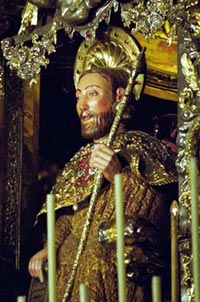
From the fourteenth century the Way into a decline, the plague has decimated the population of Europe, Christianity began to be divided (the protesters considered as acts populacheros pilgrimages), the world begins to swell and monarchs dedicate its efforts to conquer new worlds. Around the sixteenth century, the Archbishop of Santiago, Juan San Clemente, hid the body in fear losingleses approaching the city. When later Cardinal Payá occupied the seat of Compostela has newly discovered relics of the saint. He initiated a careful process he sent to Rome and finally a bubble Leon XIII "omnipotens Deus, 1 November 1884 he ratified and confirmed the award of the Special Commission of Sacred Rites Congregarción, in which reported authentic relics of Santiago and his disciples Atanasio and Teodoro. As patron of Spain, Santiago form was received at or length of our history of conquest and conquest. Now he begins the discovery of America and the new shape makes them see Santiago: Santiago's intervention was decisive in the minds of explorers and conquistadors: "And as it fell into the land yndios were frightened and said qu'Yllapa fell, I kill him and confines the sky ... And so the man went down to Santiago defend Christians. Dizen who came above a cavallo white ... and all the holy reinforced its flag and its colorful cover and undresses his sword and came with a very great destruction and death and many yndios he dislocated the whole circle of Indian Christians that the Inca had ordered Penguin and the saint was much noise and the Indian are scared of them. (..) And since the radius Indian call and tell him Santiago .. . (Strong. Guaman Poma, 1615) The seventeenth and eighteenth centuries and improve communications path includes a dispatch of prestige and receives illustrious pilgrims, however nineteenth freethinkers, scientific discoveries, the industrial revolution and urban development do not carry well with a mode life with reminiscences medieval. The crisis was so thin in 1884 León XIII dad had to declare the true remains of the Apostle reappeared in some excavations (they were hidden in the sixteenth century to the threats of incursions commissioned by the English pirate Francis Drake ). Today the pilgrimage to Santiago seems to recover the original splendor in 1985 UNESCO declared the road as jacobea Universal Heritage of Humanity. His feast is celebrated on July 25 and is the patron of Spain.
Saint-Jacques de Compostela
The pilgrimage credentials current, which comes only to those who make all or part of the Camino de Santiago by foot, bicycle or horse, has its origins in the letter, since the dawn of history Jacobean kings attached, infants, clerics, potatoes and other authorities as a guideline document to pass or pilgrimage to Compostela.
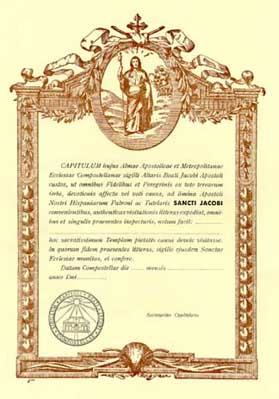
The story is the multitude of documents that are passed by the letter and all sorts of privileges due to the carrier and its accompanying protection and also get exemption from payment of fees (montazgos, Portazgo, tolls, etc.. .) that could raise cause serious problems pilgrimage to Compostela.
The card comes in associations, parishes, corporations, etc.. or where the road begins is always advisable to submit a letter or a document certifying the applicant and identify.
With the card, for those who have at least 100 kilometers on foot and bike 200, the Cathedral of Santiago received the "Compostela" which is nothing but a document that recognizes the pilgrim reaches the target and the made for "pietis cause."
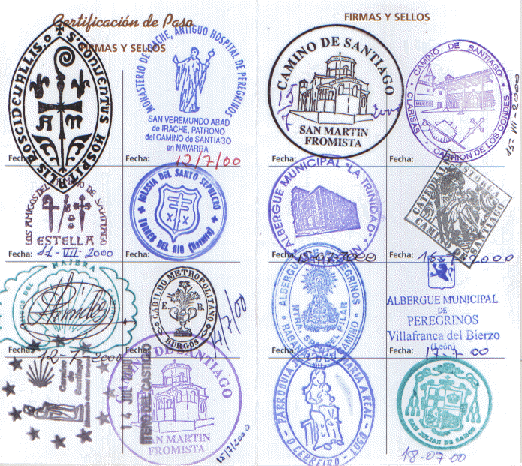
The Compostela is a document that is issued for many years. At first, they were in a roll, but long, these credentials are printed on paper with orla only feature oak leaves and scallops Jacobeas in which it is indicated in the Latin name of the pilgrim, and is signed by the current Secretary of the chapter Compostelana Church.
Path of growth at the end of this century, we are witnessing the Compostela. In 1985, 2,491 people applied in 1991 and 7274 were achieved. In 1993, the Holy Year, the Xunta launches massive plan to promote tourism and 100,000 people who get Compostela. In 1999, more than 250,000 pilgrims on foot, horseback or bicycle, more than nine million people visited Santiago.
THE CREDENTIAL
Revitalization of the Way, which has taken place in recent years has led to the creation of an official badge for the pilgrim.
Printed on cardstock, consists of 14 pages that open in the form of accordion. The first and last are those in the image below.
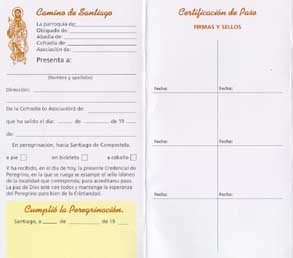
The second, in the other figure shows that, in a form intended to serve a letter that will be complemented by a church, Christian abbey, brotherhood, and so on. Foot is in space that served the pilgrimage, the pilgrim Home Office in Saint-Jacques, will seal and date, while giving Compostela.
The third page, and the other five are designed to put the stamp with the certification of passage in shelters, parishes, guilds, etc.. The reverse shows a series of maps of the Camino de Santiago. Finally, a page is devoted to clarifying the instructions read:
This card is only for pilgrims on foot, by bike or on horseback, who wish to make the pilgrimage to the Christian sense, if not seeking attitude. The degree is designed to identify the pilgrims, so that must be presented by a church, fraternity, and so on. The card has no right to the pilgrim. A two practices:
- Access to shelter offered by the hospitality of the Christian life, and
- The application of "Compostela" in the cathedral of Santiago, which is the certification of having completed the pilgrimage. The Compostela "is granted only to those who have made the pilgrimage to the Christian sense: devotionis Fonder, vel voti pietatis cause (through devotion, piety or vote) and which is granted only to make the pilgrimage to reach the tomb of the Apostle, at least the last 100 miles on foot and horseback or bicycle 200.
The pilgrim credential, therefore, may be issued by the Church through its institutions (diocese, parish, guild, and so on. Or at least, through institutions that are authorized by the Church ). Only then may be granted the "Compostela" in SAMI Catedral de Santiago (days of the Holy Year: November 1993).
The lack of shelter and subsidies should be maintained in its austerity, with the collaboration of pilgrims (cleaning, care facilities, providing the remaining financial assistance ...).
A group organized to support car or bike, please put away that alternative shelter for pilgrims.
The bearer of this certificate, accept these conditions.
This page ends with a blessing following Calixtinus Codex, written in the twelfth century:
WARNING
Of 2009 is only allowed to get Compostela bring this formal model.
reasons:
The pilgrims made the correct information on the badge.
Avoid dispersal of credentials and marketing.
Orientation to the origin of the Christian pilgrimage.
New legislation governing CASTILLA AND LEON SHEDS
That the new legislation Regulation shelters Castilla y Leon is CYT/390/2009 decree of November 17, by which the decree Rule 52/2008 of 10 July.
The same, and to summarize, so we stay away unites everyone, fracture, in principle, both parties Shelters en: Shelter profit "sin" and shelter "for profit"
The Hostels "sin animo of lucro"
You can tell because in the accreditation council will have a single shell, are shelters which, theoretically, are intended to provide shelter for pilgrims, from a point of view, non-profit, it is say, do not make money with this type of business (should be former parish and municipal shelters). But that no longer exists, I'll pay 5 € to let you sleep, without encountering many technical and sanitary shelter "for profit" and not pay taxes on economic activity.
Associations as neighbors Camino de Santiago La Portela and others who support the rights of pilgrims and businessmen of the Way, is totally unfair that the obligation to pay 5 € and tourism authorities should be established Castilian Leonesas Youthhostels law so that each pilgrim paid as they deem necessary, as it is non-profit.
Therefore, be careful when choosing the sheds with a single hull board approval, because professionals may or may not work on hospitality.
Shelter "for profit"
These shelters, which must comply with all applicable laws and to support shelters, all laws Tourism All health legislation, ..., quite contrary to the "non-profit" are those in which spoil details so that the pilgrims can have meaning, and especially a more peaceful rest of the world. In this type of hosting, there are two categories:
Hostels roads Santiago You different because in the accreditation council has two shells of gold. In this type of shelter and have no problem with the saturation of the pilgrims, and there will be a control surface pilgrims depth (1.5 m2 per pilgrim). Monitoring will also be toilets (1 toilet, sink and shower for 10 seats), restaurant service, or where appropriate, a fully equipped kitchen and dayroom for pilgrims.
Hostels "superior" on the way to Saint-Jacques: This is the category most affected in shelters of Castile and Leon and it is immune to "The Pilgrim". They stand out because they have three shells in gold accreditation board. In these shelters have maximum comfort for your rest. Control surface in the room is higher than the previous (2 m2 per pilgrim), although in the hostel we hear El Peregrino 3 m2 per pilgrim. Also in the washroom there are stricter rules (1 toilet, sink and shower for 8 seats), as in the hostel of the pilgrim has shower, toilet and sink all 4 squares (We doubled the requirements of the law). There is also the requirement to have a kitchen or, if applicable, the catering (Pilgrim's hostel has a restaurant with home cooking a very competitive price for the Pilgrim) and a dayroom for pilgrims in addition to the coffee bar.




